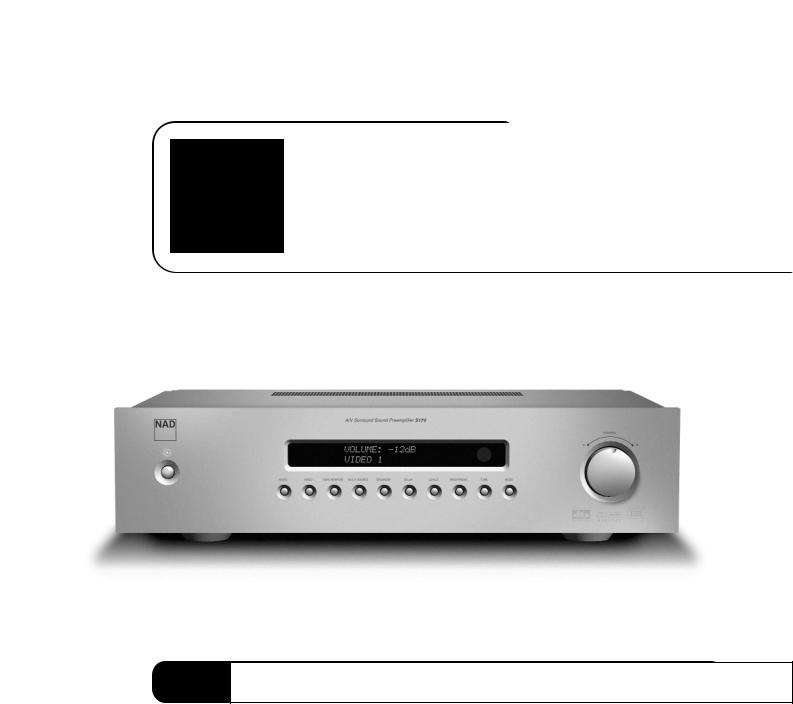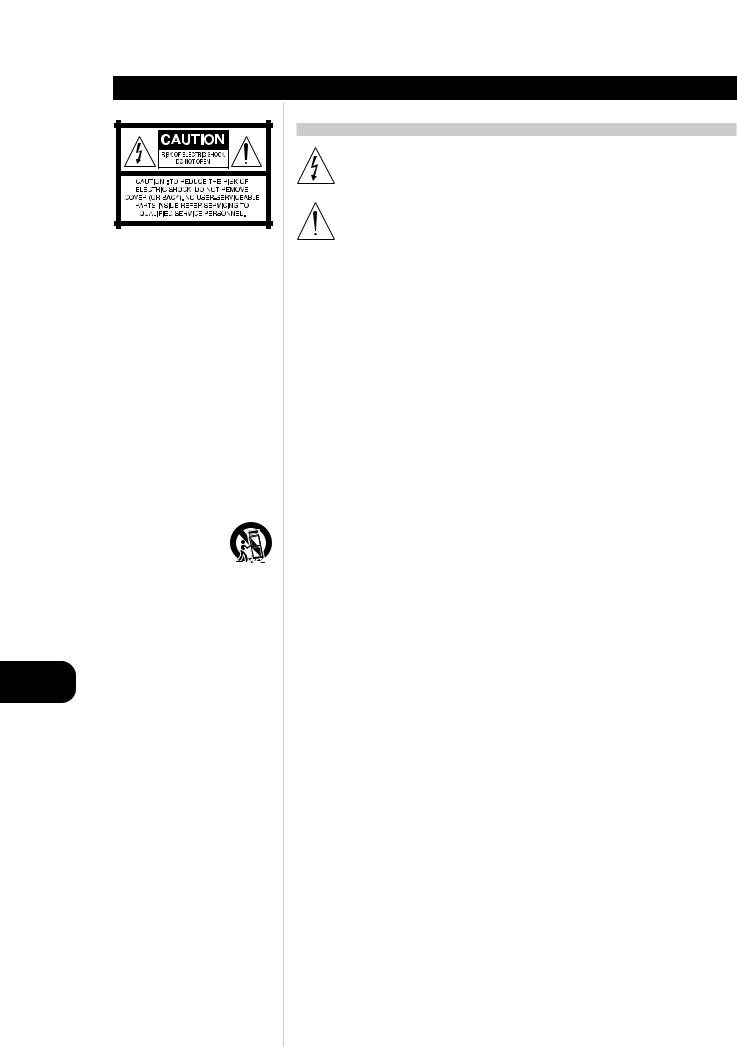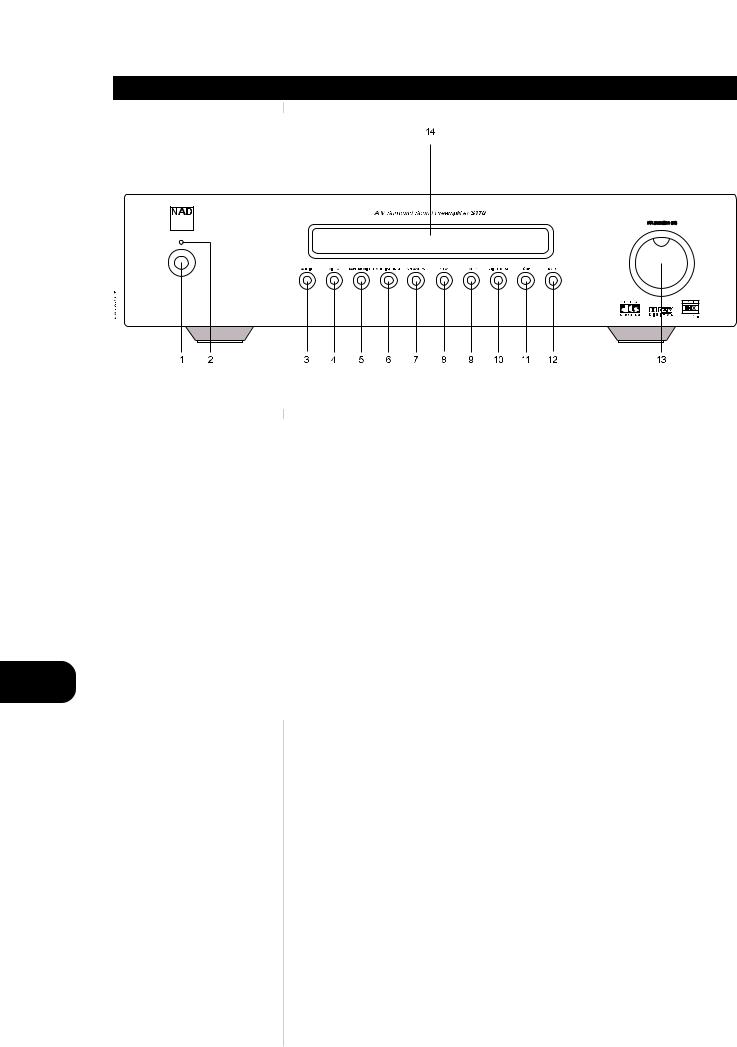NAD S170 User Manual



 S170
S170
AV Surround Sound Pre-amplifier
GB Owner’s Manual

SAFETY INFORMATION
GB
EXPLANATION OF GRAPHICAL SYMBOLS
The lightning flash with arrowhead symbol, within an equilateral triangle, is intended to alert the user to the presence of uninsulated “dangerous voltage” within the product’s enclosure that may be of sufficient magnitude to constitute a risk of electric shock to persons.
The exclamation point within an equilateral triangle is intended to alert the user to the presence of important operating and maintenance (servicing) instructions in the literature accompanying the appliance.
PRECAUTIONS
Read the Operating Instructions carefully and completely before operating the unit. Be sure to keep the Operating Instructions for future reference. All warnings and cautions in the Operating Instructions and on the unit should be strictly followed, as well as the safety suggestions below.
INSTALLATION
1Water and Moisture - Do not use this unit near water, such as near a bathtub, washbowl, swimming pool, or the like.
2Heat - Do not use this unit near sources of heat, including heating vents, stoves, or other appliances that generate heat. It also should not be placed in temperatures less than 5°C (41°F) or greater then 35°C (95°F).
3Mounting surface - Place the unit on a flat, even surface.
4Ventilation - The unit should be situated with adequate space around it so that proper ventilation is assured. allow 10 cm (4 in.) clearance from the rear and the top of the unit, and 5 cm (2 in.) from each side. - Do not place on a bed, rug, or similar surface that may block the ventilation openings. - Do not install the unit in a bookcase cabinet, or airtight rack where ventilation may be impeded.
5Objects and liquid entry - Take care that objects or liquids do not get inside the unit through the ventilation openings.
6Carts and stands - When placed or mounted on a stand or cart, the unit should be moved with care. Quick stops, excessive force, and uneven surfaces may cause the unit and cart to overturn or fall.
7Condensation - Moisture may form on the CD pickup lens when:
•The unit is moved from a cold spot to a warm spot.
•The heating system has just been turned on.
•The unit is used in a very humid room.
•The unit is cooled by an air conditioner.
When this unit has condensation inside, it may not function normally. Should this occur, leave the unit for a few hours, then try to operate again.
8Wall or ceiling mounting - The unit should not be mounted on a wall or ceiling, unless specified in the Operating Instructions.
WARNING! TO REDUCE THE RISK OF FIRE OR ELECTRONIC SHOCK, DO NOT EXPOSE THIS APPLIANCE TO RAIN OR MOISTURE
This product is manufactured to comply with the radio interference requirements of EEC DIRECTIVE 89/68/EEC and 73/23/EEC
2

ELECTRIC POWER
1Power Sources - Connect this unit only to power sources specified in the Operating Instructions, and as marked on the unit.
2Polarization - As a safety feature, some units are equipped with polarized AC power plugs which can only be inserted one way into a power outlet. If it is difficult or impossible to insert the AC power plug into an outlet, turn the plug over and try again. If it still does not easily insert into the outlet, please call a qualified service technician to service or replace the outlet. To avoid defeating the safety feature of the polarized plug, do not force it into a power outlet.
3AC power cord - When disconnecting the AC power cord, pull it out by the AC power plug. Do not pull the cord itself.
•Never handle the AC power plug with wet hands, as this could result in fire or shock.
•Power cords should be routed to avoid being severely bent, pinched, or walked upon. Pay particular attention to the cord from the unit to the power socket.
•Avoid overloading AC outlets and extension cords beyond their capacity, as this could result in fire or shock.
4Extension cord - To help prevent electric shock, do not use a polarized AC power plug with an extension cord, receptacle, or other outlet unless the polarized plug can be completely inserted to prevent exposure of the blades of the plug.
5When not in use - Unplug the AC power cord from the AC outlet if the unit will not be used for several months or more. When the cord is plugged in, a small amount of current continues to flow to the unit, even when the power is turned off.
CAUTION
Modifications or adjustments to this product, which are not expressly approved by the manufacturer, may void the user’s right or authority to operate this product.
MAINTENANCE
Clean the unit only as recommended in the Operating Instructions.
DAMAGE REQUIRING SERVICE
Have the unit serviced by a qualified service technician if
•The AC power plug has been damaged.
•Foreign objects or liquid have gotten inside the unit.
•The unit has been exposed to rain or water - The unit does not seem to operate normally.
•The unit exhibits a marked change in performance.
•The unit has been dropped, or the cabinet has been damaged
DO NOT ATTEMPT TO SERVICE THE UNIT YOURSELF
OWNER’S RECORD
For your convenience, record the model number and serial number (you will find them on the rear of your set) in the space provided below. Please refer to them when you contact your dealer in case of difficulty.
Model No. :
Serial No. :
SAFETY INFORMATION
GB
3

TABLE OF CONTENTS
GB
TABLE OF CONTENTS
Safety Information . . . . . . . . . . . . . . . . . . . . . . . . . . . . . . . . . . . . . . . . . . . . . . . . . . . . . . . . . . .2-3 Getting the Most from the NAD S170 . . . . . . . . . . . . . . . . . . . . . . . . . . . . . . . . . . . . . . . . . . . . .5 Unpacking and Setup . . . . . . . . . . . . . . . . . . . . . . . . . . . . . . . . . . . . . . . . . . . . . . . . . . . . . . . . . .6
What's in the Box. . . . . . . . . . . . . . . . . . . . . . . . . . . . . . . . . . . . . . . . . . . . . . . . . . . . . . . . . . . . 6 Choosing a Location. . . . . . . . . . . . . . . . . . . . . . . . . . . . . . . . . . . . . . . . . . . . . . . . . . . . . . . . . . 6
About the S170 . . . . . . . . . . . . . . . . . . . . . . . . . . . . . . . . . . . . . . . . . . . . . . . . . . . . . . . . . . . . .7-8
E.A.R.S. . . . . . . . . . . . . . . . . . . . . . . . . . . . . . . . . . . . . . . . . . . . . . . . . . . . . . . . . . . . . . . . . . . . 7 About THX. . . . . . . . . . . . . . . . . . . . . . . . . . . . . . . . . . . . . . . . . . . . . . . . . . . . . . . . . . . . . . . . . 7 Ease of Use . . . . . . . . . . . . . . . . . . . . . . . . . . . . . . . . . . . . . . . . . . . . . . . . . . . . . . . . . . . . . . . . 7 Integration . . . . . . . . . . . . . . . . . . . . . . . . . . . . . . . . . . . . . . . . . . . . . . . . . . . . . . . . . . . . . . . . . 7 Upgradability . . . . . . . . . . . . . . . . . . . . . . . . . . . . . . . . . . . . . . . . . . . . . . . . . . . . . . . . . . . . . . . 8 About the S70 System Remote Control . . . . . . . . . . . . . . . . . . . . . . . . . . . . . . . . . . . . . . . . . . . . 8
Quickstart . . . . . . . . . . . . . . . . . . . . . . . . . . . . . . . . . . . . . . . . . . . . . . . . . . . . . . . . . . . . . . . . . . .9
Play a DVD Movie (or Music CD) . . . . . . . . . . . . . . . . . . . . . . . . . . . . . . . . . . . . . . . . . . . . . . . . . 9
Front Panel . . . . . . . . . . . . . . . . . . . . . . . . . . . . . . . . . . . . . . . . . . . . . . . . . . . . . . . . . . . . . . . . .10
Attention! . . . . . . . . . . . . . . . . . . . . . . . . . . . . . . . . . . . . . . . . . . . . . . . . . . . . . . . . . . . . . . . . 10
Rear Panel . . . . . . . . . . . . . . . . . . . . . . . . . . . . . . . . . . . . . . . . . . . . . . . . . . . . . . . . . . . . . . . . . .11 Setting up the S170 . . . . . . . . . . . . . . . . . . . . . . . . . . . . . . . . . . . . . . . . . . . . . . . . . . . . . . . . . .12
Getting Started. . . . . . . . . . . . . . . . . . . . . . . . . . . . . . . . . . . . . . . . . . . . . . . . . . . . . . . . . . . . . 12 Using the S70 Remote . . . . . . . . . . . . . . . . . . . . . . . . . . . . . . . . . . . . . . . . . . . . . . . . . . . . . . . 12 Dealing With Hum and Noise . . . . . . . . . . . . . . . . . . . . . . . . . . . . . . . . . . . . . . . . . . . . . . . . . . 12
About the On-Screen Displays (OSD) and Front-Panel Readout . . . . . . . . . . . . . . . . . . . . . . . .13
Displaying the Menus . . . . . . . . . . . . . . . . . . . . . . . . . . . . . . . . . . . . . . . . . . . . . . . . . . . . . . . . 13
Configuring the S170 . . . . . . . . . . . . . . . . . . . . . . . . . . . . . . . . . . . . . . . . . . . . . . . . . . . . . . .14-19
Display setup . . . . . . . . . . . . . . . . . . . . . . . . . . . . . . . . . . . . . . . . . . . . . . . . . . . . . . . . . . . . . . 14 Audio setup . . . . . . . . . . . . . . . . . . . . . . . . . . . . . . . . . . . . . . . . . . . . . . . . . . . . . . . . . . . . . . . 15 Speaker Setup . . . . . . . . . . . . . . . . . . . . . . . . . . . . . . . . . . . . . . . . . . . . . . . . . . . . . . . . . . . . . 17 Level setup . . . . . . . . . . . . . . . . . . . . . . . . . . . . . . . . . . . . . . . . . . . . . . . . . . . . . . . . . . . . . . . . 17 Delay setup . . . . . . . . . . . . . . . . . . . . . . . . . . . . . . . . . . . . . . . . . . . . . . . . . . . . . . . . . . . . . . . 18 Source Setup . . . . . . . . . . . . . . . . . . . . . . . . . . . . . . . . . . . . . . . . . . . . . . . . . . . . . . . . . . . . . . 18 Trigger setup . . . . . . . . . . . . . . . . . . . . . . . . . . . . . . . . . . . . . . . . . . . . . . . . . . . . . . . . . . . . . . 19
Using theS170 . . . . . . . . . . . . . . . . . . . . . . . . . . . . . . . . . . . . . . . . . . . . . . . . . . . . . . . . . . . .20-28
Selecting Sources . . . . . . . . . . . . . . . . . . . . . . . . . . . . . . . . . . . . . . . . . . . . . . . . . . . . . . . . . . . 20 Adjusting the Volume . . . . . . . . . . . . . . . . . . . . . . . . . . . . . . . . . . . . . . . . . . . . . . . . . . . . . . . . 20 Setting Listening Modes . . . . . . . . . . . . . . . . . . . . . . . . . . . . . . . . . . . . . . . . . . . . . . . . . . . . . . 21 Adjusting Channel Levels . . . . . . . . . . . . . . . . . . . . . . . . . . . . . . . . . . . . . . . . . . . . . . . . . . . . . 24 Adjusting the Tone Controls . . . . . . . . . . . . . . . . . . . . . . . . . . . . . . . . . . . . . . . . . . . . . . . . . . . 25 Using Presets . . . . . . . . . . . . . . . . . . . . . . . . . . . . . . . . . . . . . . . . . . . . . . . . . . . . . . . . . . . . . . 25 Front Panel Operations . . . . . . . . . . . . . . . . . . . . . . . . . . . . . . . . . . . . . . . . . . . . . . . . . . . . . . . 26 Listening in a Remote Zone (MultiSource) . . . . . . . . . . . . . . . . . . . . . . . . . . . . . . . . . . . . . . . . . 27 NAD Link . . . . . . . . . . . . . . . . . . . . . . . . . . . . . . . . . . . . . . . . . . . . . . . . . . . . . . . . . . . . . . . . . 28 System Integration (RS-232) . . . . . . . . . . . . . . . . . . . . . . . . . . . . . . . . . . . . . . . . . . . . . . . . . . . 28
Troubleshooting . . . . . . . . . . . . . . . . . . . . . . . . . . . . . . . . . . . . . . . . . . . . . . . . . . . . . . . . . . . . .29 Specifications . . . . . . . . . . . . . . . . . . . . . . . . . . . . . . . . . . . . . . . . . . . . . . . . . . . . . . . . . . . . . . . .30
4

GETTING THE MOST FROM THE NAD S170
Thank you for choosing NAD.
The S170 A/V Surround Sound Preamplifier is one of the most technologically advanced surround-audio processor/preamplifiers yet devised, incorporating advanced, ultra-high-speed 32-bit digital signal processing, an architecture that is fully upgradeable (in both hardware and software), and extraordinarily precise 24-bit precision/96 kHz-sampling digital-to-analog conversion for all channels.
More importantly, it is among the most musically transparent and spatially accurate designs available, the culmination of everything we've learned, over a quarter-century, about music and home-theater sound reproduction. With our company's "Music First" design philosophy as its guiding design principle, we're confident that the S170 will make good on our promise to you of delivering both a state-of-the-art surround home-theater experience, and genuinely audiophile-quality music listening, for many years to come.
We urge you to take a few minutes now to read right through this manual. Investing a little time here at the outset might save you a good deal of time later, and is by far the best way to ensure that you make the most of your investment in the NAD S170, and get the most from this powerful and flexible hometheater component.
One more thing: We urge you to register your S170 ownership on the NAD Worldwide Web site:
HTTP://NADELECTRONICS.COM/W/REGISTRATION.HTML
This is by far the best way to ensure that we at NAD world headquarters can inform you of possible future software and firmware updates, changes that might significantly enhance the performance and utility of your S170. Please also send in your warranty card, so that your local NAD organization will have a record of your purchase, and save your original purchase receipt. This will assure you of warranty service in your area.
GB
5

UNPACKING AND SETUP
WHAT'S IN THE BOX
Packed with your S170 preamplifier you will find:
•A removable AC cable (if you wish, any IEC-standard AC cable of suitable wattage may be substituted).
•1 DC trigger cable.
•The S70 remote controller with operating manual and 9v (PP-3) battery.
•A pair of white cotton gloves—for handling your S170 during setup without fear of scratches or fingerprints marring its finish.
•This owner's manual.
SAVE THE PACKAGING
Please save the box and all of the packaging in which your S170 arrived. Should you move or otherwise need to transport your preamplifier, this is by far the safest container in which to do so. We've seen too many otherwise perfect components damaged in transit for lack of a proper shipping carton, so please: Save that box!
CHOOSING A LOCATION
We hope you will agree that the S170's finish quality and appearance earn it pride of place in any home theater or music system. Choose a location that is well ventilated (with at least several inches to both sides and behind), and that will provide a clear line of sight, within 25 feet/8 meters, between the preamp's front panel and your primary listening/viewing position—this will ensure reliable infrared remote control communications. Due to the S170's high-speed DSP hardware and high-current audio circuits it generates a modest amount of heat, but nothing that should trouble any adjacent components. It is perfectly safe to stack additional components atop the S170, or vice versa, but it is generally preferable (and considerably handsomer) if the S170 stands alone. The one exception is a power-amplifier or receiver, or any other unit that generates substantial heat: The S170 should not be stacked above or below any such component.
GB
6

Though the S170 A/V preamp is among the most powerful and sophisticated digital-surround decoder/processors available, we worked hard to make it one of the most musically transparent hometheater components as well; this is what we mean by NAD's "Music First" design philosophy. Here are just a few examples:
•The S170 employs the latest, most sonically pure high-performance FET components throughout its analog audio circuits
•Exceedingly low output impedance from all channels (long an NAD hallmark) eliminates sonic impact from cables and amplifier input-impedances
•Output muting is via reliable, sonically transparent gold-contact relays rather than sound-coloring electronics
•Gold-surfaced connectors are employed throughout both internally and externally to ensure unimpeded signal transfer.
E.A.R.S.
A key element of the S170's unique musicality is NAD’s proprietary Enhanced Ambience Recovery System (EARS). In sharp contrast to many "ambience-synthesis" music-surround modes, EARS exploits the S170’s substantial DSP power to route the ambient content that is "encrypted" in virtually all natural-acoustic recordings to the appropriate main, center and surround speakers, without resorting to artificially generated reflections or regeneration. EARS’ natural ambience yields a subtle but exceptionally effective surround mode that naturally enhances the spatial presentation in a fashion suitable for serious music listening.
On the digital side, the S170 combines extraordinarily high-speed DSP processing employing one of the most advanced high-speed DSP "engines" available, with fully 24-bit, 96 kHz-sampling-capable D/A converters (and A/D conversion for analog inputs processed for surround sound) for all channels. A single, high-precision master clock runs all digital circuits to eliminate the timing errors ("jitter") that otherwise occur between digital stages, compromising sonic performance. The result is legitimately state-of-the-art surround decoding from Dolby Digital and DTS sources in both 5.1-channel and 6.1/7.1-channel output modes, and genuinely superior sound quality in all modes.
ABOUT THX
The S170 preamplifier is certified by Lucasfilm Ltd. as meeting the rigorous requirements of its home THX/Ultra program for surround controllers. This means that it is capable of delivering an audio experience equal to that of the finest commercial cinemas when its superb fundamental performance is combined with the surround enhancements mandated by the THX/Ultra program.
EASE OF USE
While we expended enormous effort to ensure that the S170 preamplifier's sonic performance is second to none, we invested no less in making it powerfully easy to use. Its design is unusually simple for so sophisticated a component, and the S70 LCD remote controller's functioning is uniquely self-prompting and intuitive, as are the S170's own front-panel and on-screen displays. A simple yet powerful system of presets will permit you to fine-tune your listening setup for different conditions, and to recall these multiple parameters with a single keypress.
INTEGRATION
The S170 preamplifier offers extensive, flexible system-integration options through its two configurable DC triggers outputs, as well as via NAD's proprietary NAD Link inter-component communications protocol. Additionally, an RS-232 serial port stands ready to integrate the preamp with still more sophisticated controllers such as touch-screen systems and whole-house automation installations by offering two-way communication.
ABOUT THE S170
GB
7

ABOUT THE S170
UPGRADABILITY
We engineered the S170 preamplifier with selectively modular construction. All of its digital-control and - processing “intelligence” is located on a single plug in module. This sophisticated yet accessible architecture simplifies servicing while maintaining signal-path integrity, making potential hardware upgrades possible. That said, given the S170's extraordinary processing power and speed we do not foresee the need for hardware upgrades at this time. Nevertheless, you may feel confident that the S170 will not become obsolete in the foreseeable future.
Software upgrades are a more likely scenario, and are easily accomplished via the high-speed RS-232 port on the rear panel of the S170. Owners who have registered their S170s on our international web site at www.NADelectronics.com will be advised of updates (see "Getting the Most from the NAD S170," above). Updates may be free of charge, or in some cases may require royalty payments for proprietary decoding systems and the like. Computer-savvy users can perform these upgrades by downloading the files (and an installer application) from our web-site, and uploading to the S170 by connecting the preamp's RS-232 port to the PC's serial port. (See “System Integration”, page 26 for more detailed information). Alternatively, the NAD audio specialist from whom you purchased your S170 will assist you in performing software upgrades.
ABOUT THE S70 SYSTEM REMOTE CONTROL
Packed with your S170 is the NAD S70 LCD remote controller, accompanied by a short, dedicated operating manual covering its general function. We strongly recommend that you scan this manual and familiarize yourself with the S70's simple layout and operations before proceeding with setup of your S170 preamplifier; you will find that this process takes but a few minutes.
The S70 remote controller is a "paged" display; that is, each set of commands or functions shows a new array of icons on its LCD screen. This makes it a powerfully flexible commander; however, because we were careful to keep its menu structure very "shallow"— there are never more than three levels between any command and the uppermost, "top" screen—you will find it simple and intuitive to use.
Chances are, you will primarily use your S70 to command the S170 A/V preamp, but the remote can also operate other Silver Series and C-Series NAD components such as a CD player or recorder, cassette-tape component, and an AM/FM tuner. You will find the details of its function with these components in each of their owner's manuals.
GB
8

QUICKSTART
In case you simply cannot wait to experience the performance of your new S170 preamplifier, we provide the following "Quickstart" instructions to get you underway. They assume that the DVD/CD player is connected to the VIDEO1 input and that the appropriate audio and video connections have been made.
PLAY A DVD MOVIE (OR MUSIC CD)
From the S70 remote's PREAMP menu, select [@ Source]; then press the [Source up] key until VIDEO 1 appears on the front-panel readout (and on-screen display, if this is enabled; see "Display setup," below). Use the S70 remote's [VOLUME up/down] keys to adjust the volume.
Start playback of the DVD/CD player. From the S70 remote's PREAMP menu, select [MODE/MULTI.S]; then press the [Mode •] key; the [Cursor up/down] keys will now cycle through all of the S170 listening modes that are available for the current input signal type (see "About the S170's Listening Modes," below).
Depending on the signals format and connections you have made, some listening modes may not yet be available (see "Configuring the S170”, below). You may need to use the DVD player's on-screen menu system to select a surround-capable signal format.
Enjoy the movie or music, but be sure to set aside time to read this manual thoroughly and to set up, calibrate, and configure your S170 carefully.
GB
9

FRONT PANEL
1 POWER: Switch off to disconnect the S170 from all AC power and exit the Standby mode. Switching POWER on both reconnects the AC and actively power-up the preamp.
2 STANDBY: Illuminates when the S170 is in the Standby mode (dark when preamp is on, or powered-off).
3 AUDIO: Press to select audio inputs sequentially using the VOLUME (SETUP) knob (see "Front Panel Operations," below).
4 VIDEO: Press to select audio inputs sequentially using the VOLUME (SETUP) knob (see "Front Panel Operations," below).
5 TAPE MONITOR: Press to engage the Tape Monitor loop. The signal present at the rear-panel TAPE MONITOR IN jacks will be heard (see "Front Panel Operations," below).
6 MULTISOURCE: Press to select the signal output by the rear-panel MULTISOURCE OUT jacks using the VOLUME (SETUP) knob (see "Listening in a Remote Zone," below).
7 SPEAKERS: Press to access the <Speaker setup> menu on the front-
GB |
panel readout, and to select parameters using the using the VOLUME |
|
|
|
(SETUP) knob and subsequent presses of the SPEAKERS key (see |
|
"Configuring Your S170," and "Front Panel Operations," below). |
8DELAY: Press to access the <Delay setup> menu on the front-panel readout, and to select parameters using the using the VOLUME (SETUP) knob and subsequent presses of the DELAY key (see "Configuring Your S170," and "Front Panel Operations," below).
9LEVELS : Press to access the <Levels setup> menu on the front-panel readout, and to select parameters using the using the VOLUME (SETUP) knob and subsequent presses of the LEVELS key (see "Configuring Your S170," and "Front Panel Operations," below).
10BRIGHTNESS: Press to dim the S170's front-panel readout; press again to restore full brightness.
11TONE: Press to adjust treble using the VOLUME (SETUP) knob; press again to adjust bass, and a third time to exit tone-control adjustment.
12MODE: Press to select listening modes sequentially using the VOLUME (SETUP) knob (see "Setting Listening Modes," and "Front Panel Operations," below).
10
